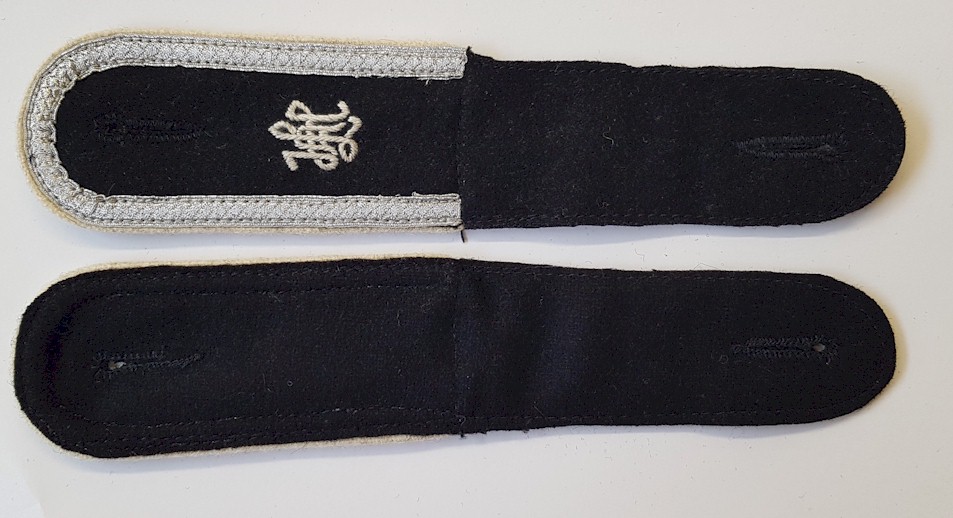GERMAN SS LAH SHOULDER BOARDS UNTERSCHARFUHRER
Unterscharfuhrer SS Leibstandarte `Adolf Hitler` shoulder boards for NCO. Comes with silver tresse and LAH embroidery in grey thread. These are the best reproduction SS boards around.
1st SS Panzer Division Leibstandarte SS Adolf Hitler
Active from Nov 9, 1933 to May, 1945, the 1st SS Panzer Division Leibstandarte SS Adolf Hitler, also known as the LSSAH, was the elite unit well known for their feats such as aiding the invasion of Poland, France, Greece and many other allied countries.
The LSSAH started off as a personal unit for Adolf Hitler, guarding him and his office in the early start of the NSDAP. In early 1923, soon after the formation of the SA unit, Adolf Hitler ordered the formation of a small separate bodyguard unit dedicated to his service rather than "a suspect mass" such as the SA. Consisting of only eight men and commanded by two members; Julius Schreck and the co-founder of both the Sturmabteilung (SA) and Schutzstaffel (SS) Joseph Berchtold. They were tasked as Stabswache (staff guard). Issued with unique badges which use the iconic Totenkopf symbol as statement of the unit's elite status.
In early May 1923 garnering 20 troops at the time Hitler redesignated the unit's name as Stoßtrupp (Shock Troop). Taking part at the Beer Hall Putsch, alongside the SA, which the aftermath of the event caused both the NSDAP and their paramilitary groups to be disbanded.
On April 13,1934, Reichsführer-SS Heinrich Himmler ordered the Leibstandarte Adolf Hitler (LAH) to be redesignated as "Leibstandarte SS Adolf Hitler" (LSSAH). Himmler insisted on adding the SS initials into the name to make it clear that the unit was independent from the SA or Whermarcht. Being known at first as a “National Socialist" unit soon evolved to the elite panzer unit division of the Waffen SS.
The LSSAH division symbol was a Skeleton Key. The decision to use this symbol was made to honour its first commander, Josef "Sepp" Dietrich (Dietrich is German for skeleton key or lock pick); it was retained and modified to later serve as the symbol for the I SS Panzer Corps.
During the war and after, the 1st SS Panzer Division Leibstandarte SS Adolf Hitler was known for its many war atrocities during the invasion of many allied countries. Murdering many prisoners of war adding to a total of an estimated 5,000 prisoners, many of the members were tried for the crimes they had committed.
Engagements:
Anschluss
German occupation of Czechoslovakia
World War II
- Invasion of Poland: LSSAH attached to the 17.Infanterie-Division and tasked with providing flank protection for the southern pincer. Fought against the Polish cavalry, Polish 28th Infantry Division and the Wołyńska Cavalry Brigade
- Battle of France: 1940 the LSSAH is now an independent motorized infantry regiment with an assault gun consisting of the Stug III. Entering through Dutch borders they slowly covered ground meeting up with other regiments. During their time in France they fought allied nations such as Britain.
- Battle of Greece: the division was tasked to stop any retreating British Commonwealth forces and to acquire valuable assets such as cities and towns.
- Operation Barbarossa: recognized for their valiant efforts the division was upgraded. Unfortunately due to timing they remained as a brigade during the operation.
Third Battle of Kharkov
Western Front 1943
- Battle of Kursk: June 1943. Under the new command of SS-Brigadeführer, Theodor Wisch, the division was refitted with more panzers and equipment. Its armor strength was 12 Tiger Is, 72 Panzer IVs, 16 Panzer IIIs and Panzer IIs, and 31 StuGs. In late June 1943, the formation of I SS Panzer Corps meant that Hausser's SS Panzer Corps was renamed II SS Panzer Corps. Preparation for Operation Citadel the division was moved north to Belgorod.
Western Front 1944
Operation Lüttich
Falaise pocket
Ardennes Offensive: part of the other divisions tasked during the Ardennes offensive.
Operation Spring Awakening: the last major German offensive launched during World War II was Operation Spring Awakening planned for 5 – 15 March 1945. The division took part after the failed Ardennes Offensive on the Western Front.
Eastern Front 1945: Battle of Berlin. The division was tasked to defend the city at any cost.
| SKU | G841 |
|---|---|
| Weight | 0.030000 |
| Country | German |
| Era | WWII |


